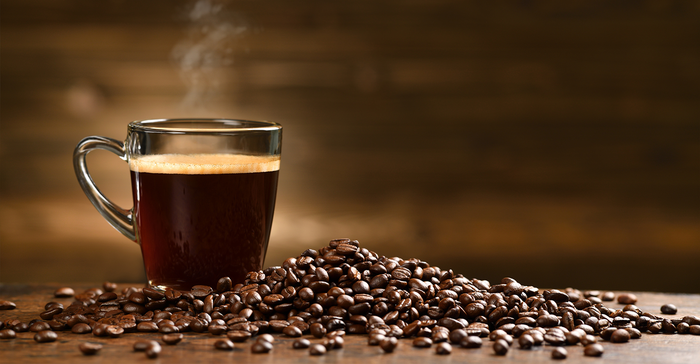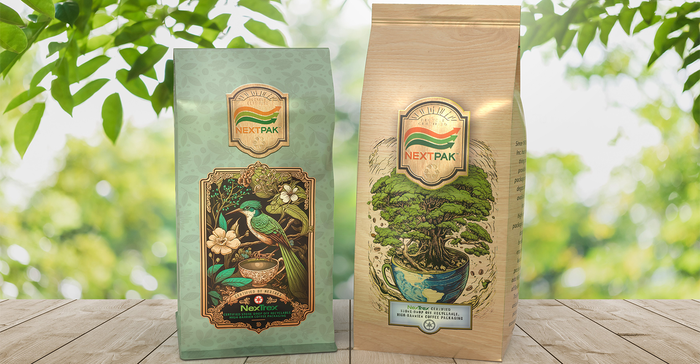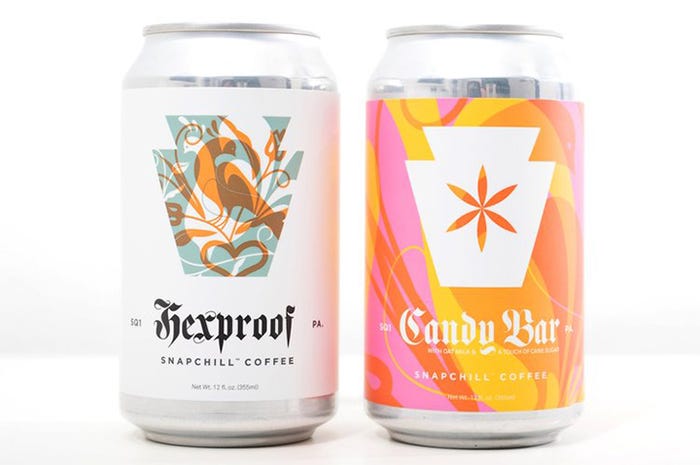Coffee's Still Hot in America, Especially When It’s Cold
Unpacking coffee trends reveals today’s types growing in popularity, preferred packaging materials, and trendy designs.

I’m surrounded by coffee snobs at work — me included. We silently judge those who come to our office and DON’T have a specific preference in their choice of coffee. There are no pods in our office, to be sure. But it’s not our fault. We live in a town that is deemed a “Coffee Destination”.
It’s a distinction of pride because my hometown of Lancaster, PA, has more than 70 coffee shops, including 9 that roast their own beans.
In this locally inspired report I’ll unpack general coffee trends, a nod to notable hometown heroes in my area, sustainability, and of course, packaging trends comprising today’s preferred choices in design and materials.
When viewed by the numbers, coffee is a booming business. The global coffee market is anticipated to reach $134.25 billion in 2024. We know that tea supersedes coffee in many parts of the world, but not here in the US. It was recently reported that 65% of adults drank coffee in the past day alone.
Factors such as the increasing out-of-home coffee consuming population, rapid urbanization, rising ecommerce sales, accelerating disposable income, increasing coffee preference, growing demand for specialty coffee, and rising green coffee consumption are driving the market.
However, growth of the industry will be challenged by weather uncertainties, retail consolidations, supply chain issues, and stringent regulations.
What types of coffee are rising to the top? Here are five.

ANEMIC181/ISTOCK VIA GETTY IMAGES PLUS
Five coffee types picking up in popularity.
1. Coffee Concentrates: Busy schedules demand fast and convenient options. Coffee concentrates, such as cold brew or espresso concentrate, allow for quick and high-quality coffee preparation without specialized equipment or lengthy brew times.
2. Cold Coffee: Cold coffee — like classic iced coffee, premium cold brew, and snap-chilled coffee — will dominate in 2024, catering to fast-paced, on-the-go lifestyles.
The rise in demand for cold coffee is also driven by climate change, with customers seeking chilled beverages year-round.
3. Cold Foam: Cold foam is now centerstage as a topping. It’s relatively low in calories and retains a creamy, meringue-like texture when added to cold drinks. Also, it can be infused with various flavors, including seasonal and plant-based options.
4. Protein Coffee: Protein coffee, or proffee, is gaining popularity as a satisfying breakfast alternative. Made with coffee and premade protein shakes or plant-based protein powders, this trend caters to customers who prefer a protein-packed start to their day.
5. Food-Topped Lattes: Coffee shops will serve lattes topped with food, drawing inspiration from beloved desserts. From freeze-dried strawberry shortcake pieces to apple crisp crumbles, these visually appealing lattes attract customers seeking indulgent treats.
Let’s get physical: Structural trends in coffee packaging.
Determining packaged coffee materials are a complex task due to product requirements for freshness and coffee’s vulnerability to outside environmental elements that pose a challenge for roasters. Also, there’s that first big packaging trend below: ecommerce and all the complexities it embodies.
Ecommerce-ready packaging on the rise: Roasters must consider that the packaging must withstand both postal and courier delivery. Additionally, the shape of the coffee bag may have to adapt to the size of letter boxes.
A return to paper packaging: With plastic being pushed out as a premier packaging choice, a return to paper packaging is underway. Both kraft paper and rice paper packaging have never been more in demand.
Originating from the German word kraft meaning strong, kraft paper is made of a minimum 80% sulfate wood pulp. It’s coarse and exceptionally strong, making it well suited for packaging. It’s sometimes made with a rough surface to prevent bags from sliding off pallets.
The global kraft paper industry exceeded $17 billion last year due to increased demand for sustainable and recyclable packaging materials.
Nowadays, environmental awareness isn’t a trend — it’s a requirement. Sustainable coffee bags, including recyclable, biodegradable, and compostable options are all available, with more options undoubtedly on the horizon this year.

FRES-CO SYTEMS
Fres-co System USA’s NextPak flexible coffee packaging is the first ultra-high-barrier package approved for store drop-off recycling.
A strong focus on anti-counterfeit packaging: Consumers are increasingly passionate about where their specialty coffee originates, and whether their purchases benefit its producers. Sustainability in its broadest definition is a major factor in coffee. The industry needs to rally behind sustainability initiatives that promote ethically produced coffee to support the livelihoods of the 25 million coffee growers across the globe.
Eliminating best-by dates: Food waste is a global concern, with experts estimating it tallies a whopping $17 trillion in loss per year. As a result, roasters are moving away from best-by dates for coffee to reduce the amount of waste sent to landfill.
Because it is more shelf-stable than other perishable items, with only the taste degrading over time, roasters are using roasted dates and quick-response codes as a better solution to communicate key product attributes including when the coffee was roasted.
Now onto design. What visual elements are coffee companies using to catch your eye and your dollars?
Ways coffee roasters persuade your purchase.
This year, we’ve seen packaging design trends that collaborate bold colors, eye-popping images, minimalist designs, and retro-feeling fonts across most categories. Coffee is no exception. Here are examples for three types.
1. Bold Fonts/Shapes: Using typography as the centerpiece is still hot. A burst of color, pattern, and things that don’t quite go together but somehow work. Dark Matter Coffee is a Chicago-based roaster with a huge attitude and cult-like following. As stated in Bon Appetit, Dark Matter started designing edgy, colorful artwork because “coffee packaging can be boring.” They commission local Chicago artists to create their packaging artwork, and release a limited-edition coffee variety monthly featuring that art such as the example below. The company has adapted this same approach with the décor of their brick-and-mortar locations, including a pop-up store at Chicago’s United Center.
It goes without saying that Starbucks has used minimal packaging design for quite some time, but more recently the company has branched out to more creative designs, too.

STARBUCKS COFFEE CO.
2. Minimalism: This trend is seen across all types of products from perfume to dairy, to sweets and snacks, and coffee, too. Minimalist packaging design is a great way to communicate better with consumers at retail. It stands out on the shelf and proclaims with simplicity “this is quality.”
3. 60s meets the 90s: This is simply a way of saying “everything once old is new again…and again. From Nirvana-inspired fonts to designs that look straight out of Haight-Ashbury, the rock and roll ethos of boldness with ideology is back in a big way. A big shout out to my local favorite roasters: Square One Roasters. Their packaging is whimsical, lighthearted, and airy feeling, with wispy illustrations of birds on each package.

SQUARE ONE ROASTERS
4. Everything is a QR code away: It’s all about connectivity. Quick response codes allow brands to invite consumers into their world, whether it’s how to use a product to its best effect, or to explore social media channels. QR codes deliver packaging from long-form messaging because the code takes consumers to video content or animation in new ways. Also, QR codes allow coffee companies the freedom to not have to explain key product details on the packaging, allowing for more leeway in design.
About the Author(s)
You May Also Like




